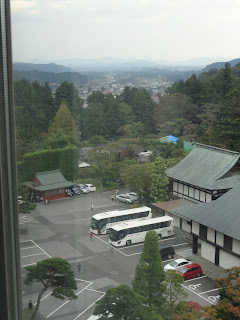Having been back
from the Japan trip for a few days, I decided that jet lag was no longer an
excuse for inactivity. Time to rearrange
the tractor stable, the red barn.
Unlike barns of
old, this cleanup didn’t require a scoop shovel. It required a “tugboat”.
The 2N Ford
tractor answered the call. Two of the
old fellers left the barn under their own power. Two needed help.
The lineup: R, 820, 830 (all diesels), and G (gas, and left
outside due to being saddled with the Farmhand). The left front tire of the R would not hold
air, so the 820 was forced to lend a hand, or a foot, or whatever, to get the R
mobile.
The Ford had no
trouble emptying the shed. A chain
running through a pipe served to pull the R and the D from their stalls. Pulling worked well. When it came time to push, however, it got a
little more complicated. A piece of
angle iron got pressed into service, and the D went gently into its new stall.
The R was a bit
more difficult. It was “never broke to
lead”. A longer chain came into play in
order to keep the Ford out of the way when the R decided to coast during the maneuver
to get it turned around and headed back into the barn.
Once in the
barn, I could shorten up the chain. I
had to switch from pulling to pushing for the last move. The Ford wasn’t up to the task. The wheels would spin in the loose dirt of
the barn floor, the Ford rear end would shift left or right, the angle iron
would pivot and fold back parallel to the R front axle, and the R would not
move.
After a few
attempts, the sun sank slowly in the west, and my energy ebbed with the
sunset. Several trips from Ford to R to
turn the steering wheel this way or that way took their toll. Maybe jet lag? The project had to be put off until the next
day.
Ultimately, the
830 was pressed into service. The 820
would have been easier to use, easier to see and to get off and on rather than
up and into with the 830’s cab. But the
820 was missing its left front wheel.
The three feet
of angle iron didn’t allow much for safely stopping if something went
amiss with the pushing operation. On the other hand, the front end
of the 830 wasn’t nearly as easily brushed aside, as had been the Ford’s rear-end. Once lined up with the R, the 830 easily
shoved it back into place. It took two
or three hitches, realigning a couple of times, but it happened without
incident.
Some work
remained to do. Put the combine header
back in, putting the wheel back on the 820 and getting it back in the barn,
finally putting the 830 in and draining the water out of it. It all got done.
When we left for
Japan, the MET tower (http://50farm.blogspot.com/2017/09/things-going-down-lots-of-thingswent.html)
in the middle of the field was gone, but not the concrete base. I didn’t want to press the issue until the
millet was picked up. I had made one unanswered
call and left a voice may message, but I never got a reply. I put it off.
I was all set to
engage the wind energy company in that battle.
I went out to case the place and see what it would take to get rid of
the concrete, or at least get it down below the surface far enough to be able
to farm over it.
It wasn’t there! Some good shoemaker’s elves had been there
and done the work for me while I slept.
A week or two
later, I got a notice from Verizon that I had a new voice message. When I accessed my voice mail, I had nine new messages, two of which were
from the wind energy boys.
The phone was
shut off during the time we were in Japan.
When I reactivated it, it forgot to mention that I had a bunch of missed
calls and several voice messages. Thanks
to good ol’ Verizon for updating me with a new
and improved mailbox. (Every voice
message takes an additional thirty seconds to listen to now, as the mechanical voice
tells me the number or name of the person the message came from, the day, the
hour, and the message duration.)
One of the messages informed me that the wind energy company had hired another contractor to come in with a backhoe or some other such tracked
earthmover to get the concrete out of there.
I called the guy in charge.
He
wasn’t happy with the first two guys who felled the tower. They were supposed to do the entire job, he
said. He said they did a lousy job. I said they really did a good job, destroying
very little of the crop in removing the tower and its appurtenances. He insisted they were hired to do the whole
job. I pointed out that they really
weren’t equipped to handle the bigger chunk of concrete. I didn’t change his mind. I thanked him for getting the job done.
The contractor
did manage to do it when it was muddy, but I didn’t complain. As long as I don’t snag on a big chunk of
concrete with a chisel or disk, I will be happy. No more guy wires to dodge. No loose cables to avoid. The bat-chirping trailer also disappeared. From six objects to avoid, I’m down to one,
the wind tower itself.





















